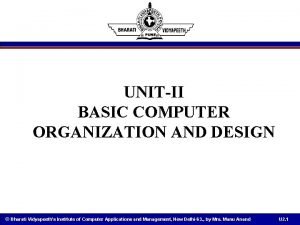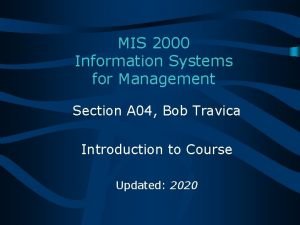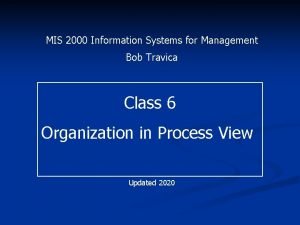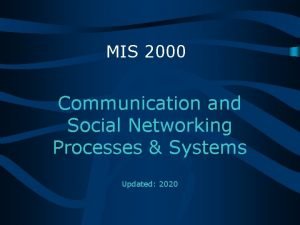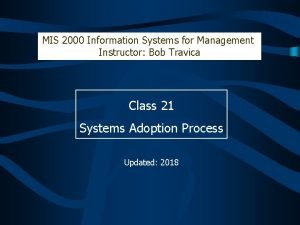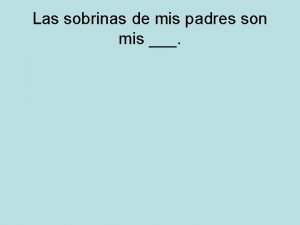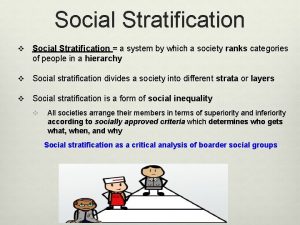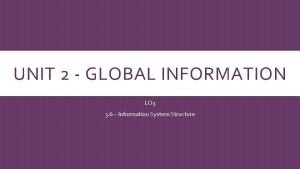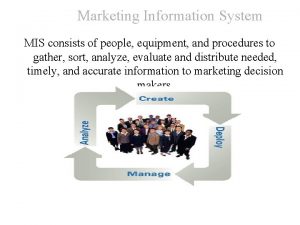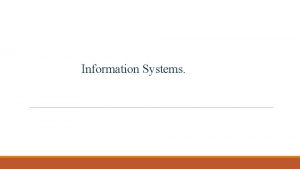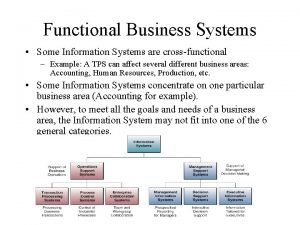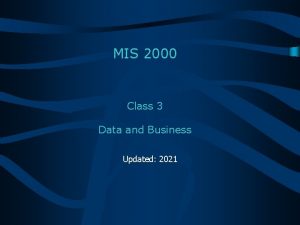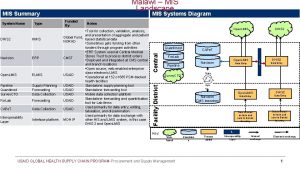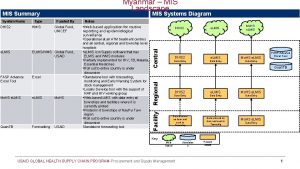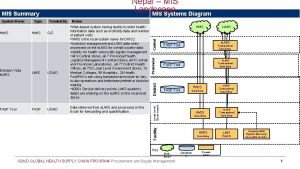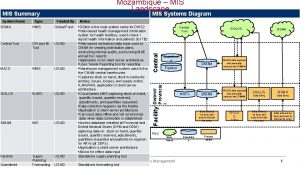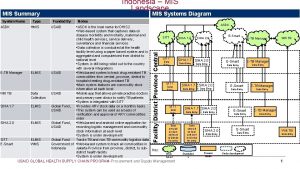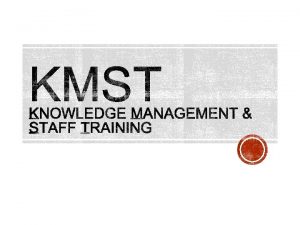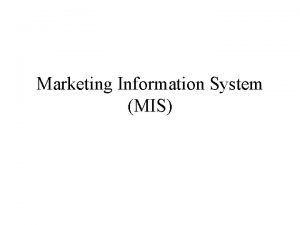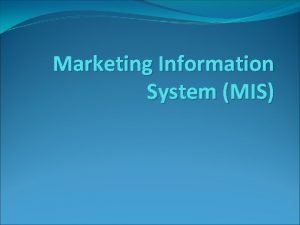MIS 2000 Class 19 System Development Process Updated


















- Slides: 18

MIS 2000 Class 19 System Development Process Updated 2021

Outline • System Development Process • System Planning • System Analysis & Design • System Construction, Installation, Testing • System Deployment & Maintenance • Good System Design 2

System Development Process 1 Plan System àPlaining what organizational goals an IS needs to meet; also the economic side of IS (costs, benefits) 2 Conduct System Analysis 3 Design System àDesigning system solutions for problems in processes & data; How to make To-be system * 4 Construct System àMaking the system physically; programming, purchasing software & hardware 5 Install & Test System àPutting software on hardware + check how it works; a reality check (testing the quality of work in earlier phases) 6 àRolling a system out to users and fine-tuning it while being used Deploy & Maintain System àAnalyzing business processes and data As-is and as Tobe; an As-is system usually have problems 3

System Development Process Waterfall Logic • System development steps can be run on the entire system sequentially in defined X periods. • Good: – Order imposed on systems development; – timing control (planning start & end dates of tasks and phases); Plan System 0 Conduct System Analysis Design System 1 Construct System – project documentation created. • Problems: – Linear, finish one step, move to the next. – If development time is longer, system may be obsolete at time of release. Install & Test System Deploy & Maintain System 2 years 4

• Newer methodologies of systems development are - faster - build a system in smaller parts - each developed part is tested on users and revised (iterations)* • Same development activities repeated (as in Waterfall) on system parts and usually several times on each part. RAPID SYSTEM DEVELOPMENT DEPLOYMENT 5

Check Point 1: Answer Questions Below 1. Put the number next to a phase name from top-down to show the sequence of phases in the waterfall methodology. Your answer should be a sequence of numbers with no spaces between (e. g. , 653421, the total of six digits): ___ ___ ___ 2. design construct install and test analyze plan deploy and maintain Identify characteristics of the Waterfall and Rapid methodology; for Waterfall write 1, and for Rapid write 2. Your answer should be a sequence of numbers with no spaces between (e. g. , 121212, , the total of six digits): Developing system piece by piece ( ); Developing system phase by phase ( ); Repeating development activities ( ); Each system part developed quickly ( ); Risk of building an obsolete system ( ); Better control of time for system development ( ). Q 6

1 Plan System 2 System Analysis 3 Design System 4 Construct System 5 Install & Test System 6 Deploy & Maintain System Plan System Business goals and plans to be accomplished with new system; focusing on particular processes in order to: Optimize process design (CCCF aspects) Improve process performance (CVCT vs. CCCF aspects) Also, define new processes What are the costs and financial returns expected from the process/IS changes? How does IS in planning can help to accomplish goals above? Your IS IS you need 7

Perform System Analysis 1 Plan System 2 System Analysis 3 Design System • The goal is to understand the existing (present) business and systems (As-is) in order to envision improvements (To-be system). • Focus on the present and future: 4 Construct System 5 Install & Test System – Analysis of present organizational processes (design, performance) and what can be improved - interview end-users & managers. 6 Deploy & Maintain System – Analysis of present data and what else is needed (business documents like reports, communications) – Analysis of IT in the existing system and possible improvements (changes, to-be system) • Result: System requirements – defining what new IS should deliver Analyze business, data & IT/IS Define System Requirements 8

1 Plan System Design System 2 System Analysis 3 Design System 4 Construct System 5 Install & Test System 6 Deploy & Maintain System • Changes that system requirements trigger • Creating a new IS or upgrading the present IS; still just on “paper”. • The data model is created or changed in case of upgrade. • The processing of data in the system is defined according to the model of organizational processes resulting from System Analysis. • User Interface is designed (content and look of screens, & their sequence). STUDENT database Data model Processes model User interface Mock-ups 9

1 Plan System 2 System Analysis Construct System 3 Design System 4 Construct System 5 Install & Test System 6 Deploy & Maintain System • A system is physically made based on the design created (data diagrams, and process diagrams that determine what software should do – how the data should be processed). • Options for acquiring software & hardware: – Write application software (in house, or by external vendors) – Buy application software (off-the-shelf software) – Rent application software – Purchase computers and other hardware Paired rather than individual programming is often practiced today as part of rapid IS development. Q 10

1 Plan System 2 System Analysis Install & Test System 3 Design System 4 Construct System 5 Install & Test System 6 Deploy & Maintain System • Installation: Setting up a system into operation stage. Software is mounted on hardware, etc. • Testing: Evaluating the performance of a developed system. • Kinds of tests run based on moving from small to large : 1. Unit testing (system part, by experts) 2. System testing (whole system, by experts) 3. Acceptance testing (whole system, by users) 11

System Deployment Methods 1 Plan System 2 System Analysis 1. Direct deployment - New system completely replaces old one - Higher risk, lower cost 3 Design System 4 Construct System 5 Install & Test System 6 Deploy & Maintain System OLD IS NEW IS time Old out/New in 2. Parallel deployment – Old and new system used until the new proves reliable – Lower risk, higher cost OLD IS Q NEW IS New in time Old out 12

Maintain System in Production Stage 1 Plan System 2 System Analysis 3 Design System 4 Construct System 5 Install & Test System 6 Deploy & Maintain System • As IS is used and managed, its development continues in small - this is the system maintenance domain. • System maintenance includes: – De-bugging software – IS modifications based on business needs (e. g. , enlarging data storage) – Adding new software and hardware driven by vendors 13

Good System Design A well-designed IS system needs to: 1. Do the work it is planned to support – fit with business processes 2. Be easy to learn and use - user interface quality, menu design: – intuitive screen items (labels, buttons; see screens below – there are ups and down to each design) Drop-down menu design Tabs menu design • • Font options available in 2 steps Menu takes less of screen space Q Font options readily available Menu takes more of screen space, main menu size varies More… 14

– screens reasonably complex (screens of enterprise systems can be very complex) Enterprise System screen, Menus are red: Complex Navigation High learning time – lets users know always where they are (tips/feedbacks, no duplication of menu items across screens; shallow menus) – allows for easy tracking and correction of errors 3. Support efficient work - user interface & technical aspects (nonfunctional proiperties). Impacts on process performance (timing, costs). 15

Good design is goal but this might happen… 1 2 3 But… 16

Good design is goal but this might happen… 1 2 3 17

Summary • System development process takes activities of planning, analysis, designing, constructing, installing, testing, and deploying, and maintaining an IS. • Structural and newer rapid methodologies. • Plan for new IS can aim at optimizing process design, improving process performance, and creating new processes. • System Analysis focuses on both business and existing IS (if any) to understand how work is done and how it should be. System design creates new functions, data model, user interface. • IS construction implements IS design physically. • There are 3 methods of IS testing and 2 basic deployment strategies. • System maintenance continues throughout the system use period. • Well-designed IS performs work needed, is easy to learn and use, and enables efficient work. 18
 During _______ branching, only car is updated with adr
During _______ branching, only car is updated with adr Rpms cycle phase 2
Rpms cycle phase 2 Mis 2000
Mis 2000 Mis 2000
Mis 2000 Mis 2000
Mis 2000 Mis 2000
Mis 2000 Principios proyecto de vida
Principios proyecto de vida El hermano de mi madre es mi ___.
El hermano de mi madre es mi ___. Mis mai a mis tachwedd
Mis mai a mis tachwedd Mis mai a mis tachwedd
Mis mai a mis tachwedd Mis actos son un reflejo de mis creencias
Mis actos son un reflejo de mis creencias Rheda 2000
Rheda 2000 Caste vs class
Caste vs class Religion and conflict theory
Religion and conflict theory Open and closed system in thermodynamics
Open and closed system in thermodynamics The mis consists of
The mis consists of Management information system example
Management information system example Transaction processing system in mis
Transaction processing system in mis Cross functional system
Cross functional system
